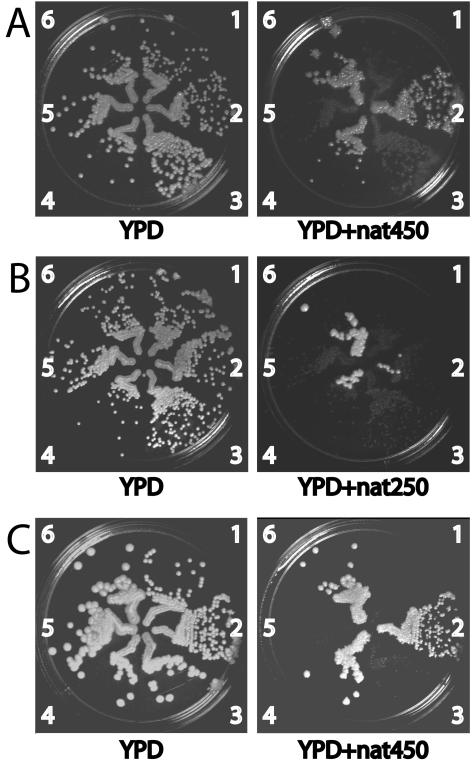FIG. 5.
Nourseothricin resistance phenotypes of clinical isolates of C. albicans and other Candida species. Clinical Candida isolates and their CaNAT1-containing transformants were streaked next to each other on YPD. They were then replica plated onto YPD with 250 (YPD+nat250) or 450 (YPD+nat450) μg of nourseothricin/ml. (A) C. albicans bloodstream isolates. 1, JKC8 (wild-type bloodstream isolate); 2, JKC410 (JKC8 transformed with pJK850); 3, JKC9 (wild-type bloodstream isolate); 4, JKC412 (JKC9 transformed with pJK799); 5, JKC7 (wild-type bloodstream isolate); and 6, JKC408 (JKC7 transformed with pJK850). (B) C. parapsilosis clinical isolates. 1, JKC355 (wild-type clinical isolate); 2, JKC414 (JKC355 transformed with pJK850); 3, JKC357 (wild-type clinical isolate); 4, JKC416 (JKC357 transformed with pJK799); 5, JKC358 (wild-type clinical isolate); and 6, JKC419 (JKC358 transformed with pJK850). (C) Candida species clinical isolates. 1, JKC356 (C. lusitaniae wild type); 2, JKC420 (JKC356 transformed with pJK799); 3, JKC361 (C. glabrata wild type); 4, JKC424 (JKC361 transformed with pJK850); 5, JKC359 (C. kefyr wild type); and 6, JKC426 (JKC359 transformed with pJK850).

